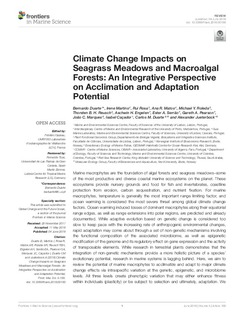| dc.contributor.author | Duarte, Bernardo | |
| dc.contributor.author | Martins, Irene | |
| dc.contributor.author | Rosa, Rui | |
| dc.contributor.author | Matos, Ana R. | |
| dc.contributor.author | Roleda, Michael | |
| dc.contributor.author | Reusch, Thorsten B. H. | |
| dc.contributor.author | Engelen, Aschwin H. | |
| dc.contributor.author | Serrão, Ester A. | |
| dc.contributor.author | Pearson, Gareth A. | |
| dc.contributor.author | Marques, João C. | |
| dc.contributor.author | Caçador, Isabel | |
| dc.contributor.author | Duarte, Carlos M. | |
| dc.contributor.author | Jüterbock, Alexander Oliver | |
| dc.date.accessioned | 2018-09-21T08:44:59Z | |
| dc.date.available | 2018-09-21T08:44:59Z | |
| dc.date.created | 2018-06-05T20:29:14Z | |
| dc.date.issued | 2018-06-04 | |
| dc.identifier.citation | Frontiers in Marine Science. 2018, 5 . | nb_NO |
| dc.identifier.issn | 2296-7745 | |
| dc.identifier.uri | http://hdl.handle.net/11250/2563839 | |
| dc.description.abstract | Marine macrophytes are the foundation of algal forests and seagrass meadows–some of the most productive and diverse coastal marine ecosystems on the planet. These ecosystems provide nursery grounds and food for fish and invertebrates, coastline protection from erosion, carbon sequestration, and nutrient fixation. For marine macrophytes, temperature is generally the most important range limiting factor, and ocean warming is considered the most severe threat among global climate change factors. Ocean warming induced losses of dominant macrophytes along their equatorial range edges, as well as range extensions into polar regions, are predicted and already documented. While adaptive evolution based on genetic change is considered too slow to keep pace with the increasing rate of anthropogenic environmental changes, rapid adaptation may come about through a set of non-genetic mechanisms involving the functional composition of the associated microbiome, as well as epigenetic modification of the genome and its regulatory effect on gene expression and the activity of transposable elements. While research in terrestrial plants demonstrates that the integration of non-genetic mechanisms provide a more holistic picture of a species’ evolutionary potential, research in marine systems is lagging behind. Here, we aim to review the potential of marine macrophytes to acclimatize and adapt to major climate change effects via intraspecific variation at the genetic, epigenetic, and microbiome levels. All three levels create phenotypic variation that may either enhance fitness within individuals (plasticity) or be subject to selection and ultimately, adaptation. We review three of the most important phenotypic variations in a climate change context, including physiological variation, variation in propagation success, and in herbivore resistance. Integrating different levels of plasticity, and adaptability into ecological models will allow to obtain a more holistic understanding of trait variation and a realistic assessment of the future performance and distribution of marine macrophytes. Such multi-disciplinary approach that integrates various levels of intraspecific variation, and their effect on phenotypic and physiological variation, is of crucial importance for the effective management and conservation of seagrasses and macroalgae under climate change. | nb_NO |
| dc.language.iso | eng | nb_NO |
| dc.rights | Navngivelse 4.0 Internasjonal | * |
| dc.rights.uri | http://creativecommons.org/licenses/by/4.0/deed.no | * |
| dc.subject | Seagrass | nb_NO |
| dc.subject | Kelp forests | nb_NO |
| dc.subject | Microbiome | nb_NO |
| dc.subject | Epigenetics | nb_NO |
| dc.subject | Global climate change | nb_NO |
| dc.title | Climate Change Impacts on Seagrass Meadows and Macroalgal Forests: An Integrative Perspective on Acclimation and Adaptation Potential | nb_NO |
| dc.type | Journal article | nb_NO |
| dc.type | Peer reviewed | nb_NO |
| dc.description.version | publishedVersion | nb_NO |
| dc.rights.holder | Copyright © 2018 Duarte, Martins, Rosa, Matos, Roleda, Reusch, Engelen, Serrão, Pearson, Marques, Caçador, Duarte and Jueterbock. | nb_NO |
| dc.source.pagenumber | 23 | nb_NO |
| dc.source.volume | 5 | nb_NO |
| dc.source.journal | Frontiers in Marine Science | nb_NO |
| dc.identifier.doi | 10.3389/fmars.2018.00190 | |
| dc.identifier.cristin | 1589269 | |
| cristin.ispublished | true | |
| cristin.fulltext | original | |
| cristin.qualitycode | 1 | |

